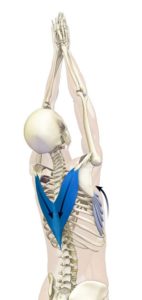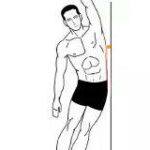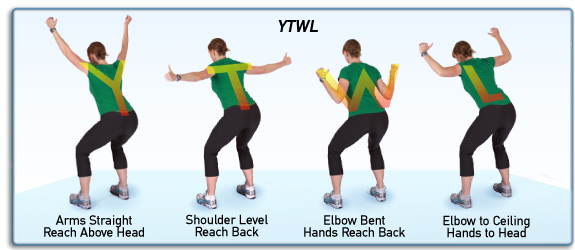Our trapezius or “traps” divide into three sections. They have have radically different shapes, fiber directions and primary movement functions. Yet, this does still behave as one muscle. In particular, when our lower traps are weak or inhibited, our upper and middle traps will try to assist.
One of the primary functions of the upper traps is to elevate the shoulders. However, one of the primary depressors of the shoulder are your lower traps. The only other shoulder depressor is serratus anterior. So, any attempt to “help” from our upper traps tends to elevate our shoulders and lock them in a battle they cannot win.
Compressing the Lower Traps
 The lower traps run from the your spine up and out in a V-shaped pattern towards the lower, inside edge of your shoulder blades. They pull your shoulder blades down and inward.
The lower traps run from the your spine up and out in a V-shaped pattern towards the lower, inside edge of your shoulder blades. They pull your shoulder blades down and inward.
When your arms are at your sides they are much shorter than depicted here. In that position, you can use a tennis ball in a sock or a well designed tool like the BackKnobber to reach trigger points in your lower traps.
This reclining position allows you to completely relax the shoulder while compressing these trigger points.
 Serratus anterior comes off your ribs and attaches your shoulder blade. It pulls your shoulder blade down and out. To reach your serratus anterior, we recommend using two tennis balls in a sock between your upper ribs and a wall.
Serratus anterior comes off your ribs and attaches your shoulder blade. It pulls your shoulder blade down and out. To reach your serratus anterior, we recommend using two tennis balls in a sock between your upper ribs and a wall.
Strengthen The Shoulder Depressors
The lower trapezius muscles are activated by drawing the shoulder blades down while keeping the arms straight. Serratus anterior is activated by stabilizing against extending the arms down and out from the shoulder. YTWL is a series of stabilizing exercises designed to engage the lower trapezius muscle. Note that there is no equipment required. This exercise can be done at any time during the day and almost anywhere, including your desk.
Bend slightly at the hips. It is a little hard to see but the model is making a “thumbs-up” with their hands. This is a CRUCIAL aspect of these exercises. Keep your thumbs pointing back behind you throughout the exercise. Tuck your chin and retract your neck.

Notice the colored lines on the back of the model. These lines indicate the direction in which your muscles should be moving. You can see that there is a constant downward motion towards the hips. When you are going through the exercises visualize your muscles sliding down your back.
Focus on the area highlighted in orange as your prime activation sight. These are dynamic exercises. However, they should perform them in a slow and controlled manner.
Begin with a set of 5 repetitions. Focus on getting the form correct and activating the proper muscles. Gradually increase to 10 repetitions over 1-2 weeks making sure you keep good form. Increase to 2 or 3 sets as desired.
YTWL By The Letters
Let’s break this acronym down.
Y: From the bent over position straighten your arms and lock out your elbows. Raise your arms overhead to form a “Y”. Your goal here is to keep your upper traps soft and relaxed and you should feel a nice burn in your lower traps and maybe in between your shoulder blades. Hold for one to two seconds before returning to a relaxed position. If you cannot get your upper traps to relax try bringing your arms a little wider.
T: Same positioning as the Y but this time bring your arms out to the side with your wrists in line with your shoulders to form a “T”. Again, the focus is on drawing your shoulder blades down towards your waist and away from your ears. Hold for one to two seconds before relaxing.
W: Bend at the elbows to form a “W” shape with the arms (hands, elbows, and shoulder joint). Pull your shoulder blades down and back and hold for a few seconds focusing on the contraction. Release and relax.
L: From the bent over position draw your elbows back just like you were going to do the “T” but this time bend your elbows with your knuckles facing the floor. Hold your elbows here and then rotate your forearm so that the backs of your hands are facing the ceiling (remember to try and rotate your thumbs back as much as you can). Hold for a brief moment before relaxing.
